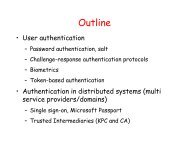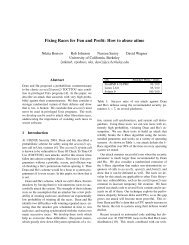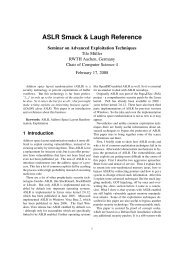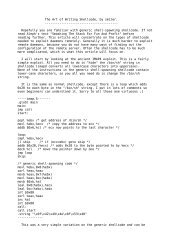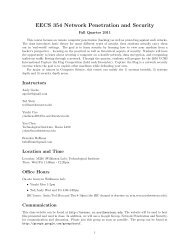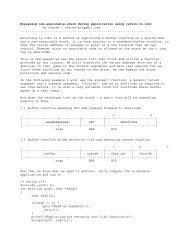Advanced Return to libc Exploits
Advanced Return to libc Exploits
Advanced Return to libc Exploits
You also want an ePaper? Increase the reach of your titles
YUMPU automatically turns print PDFs into web optimized ePapers that Google loves.
esolution algorithm).<br />
As we see, this piece of code pushes $reloc_offset on<strong>to</strong> the stack<br />
and jumps at the beginning of .plt section. After a few instructions, the<br />
control is passed <strong>to</strong> dl-resolve() function, reloc_offset being one of its<br />
arguments (the second one, of type struct link_map *, is irrelevant for us).<br />
The following is the simplified dl-resolve() algorithm:<br />
1) calculate some_func's relocation entry<br />
Elf32_Rel * reloc = JMPREL + reloc_offset;<br />
2) calculate some_func's symtab entry<br />
Elf32_Sym * sym = &SYMTAB[ ELF32_R_SYM (reloc->r_info) ];<br />
3) sanity check<br />
assert (ELF32_R_TYPE(reloc->r_info) == R_386_JMP_SLOT);<br />
4) late g<strong>libc</strong> 2.1.x (2.1.92 for sure) or newer, including 2.2.x, performs<br />
another check. if sym->st_other & 3 != 0, the symbol is presumed <strong>to</strong> have<br />
been resolved before, and the algorithm goes another way (and probably<br />
ends with SIGSEGV in our case). We must ensure that sym->st_other &<br />
3 == 0.<br />
5) if symbol versioning is enabled (usually is), determine the version table<br />
index<br />
uint16_t ndx = VERSYM[ ELF32_R_SYM (reloc->r_info) ];<br />
and find version information<br />
const struct r_found_version *version =&l->l_versions[ndx];<br />
where l is the link_map parameter. The important part here is that ndx must<br />
be a legal value, preferably 0, which means "local symbol".<br />
6) the function name (an asciiz string) is determined:<br />
name = STRTAB + sym->st_name;<br />
7) The gathered information is sufficient <strong>to</strong> determine some_func's address.<br />
The results are cached in two variables of type Elf32_Addr, located at<br />
reloc->r_offset and sym->st_value.<br />
8) The stack pointer is adjusted, some_func is called.<br />
Note: in case of g<strong>libc</strong>, this algorithm is performed by the fixup() function,<br />
called by dl-runtime-resolve().<br />
----[ 5.4 - The conclusion<br />
Suppose we overflow a stack buffer with the following payload<br />
--------------------------------------------------------------------------<br />
| buffer fill-up | .plt start | reloc_offset | ret_addr | arg1 | arg2 ...<br />
--------------------------------------------------------------------------<br />
^<br />
|<br />
- this int32 should overwrite saved return address<br />
of a vulnerable function




